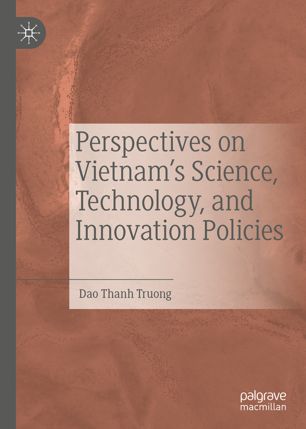![[Sách] Một tiếp cận về chính sách STI của Việt Nam trong bối cảnh hội nhập quốc tế](/uploads/ussh/news/2020_01/sach1-3-20200107131721468.jpg)
"Perspectives on Vietnam's Science, Technology and Innovation Policies" is the title of a book selected by Springer, one of the world's leading publishers, for publication in print in January 2020.

With a systematic approach and concise writing style, author Dao Thanh Truong provides readers, especially professional researchers, with an overview of Vietnam's science, technology, and innovation (STI) system and related policy perspectives. Simultaneously, the author raises thought-provoking issues regarding the development of a complete, adaptable, and integrated STI system in Vietnam within the current regional and international context. These are also the main research findings of state-level projects (project KX06.06/11-15 on “Research and analysis of Vietnam's STI/innovation system in the trend of international science and technology integration” and project KX01.01/16-20 on “Social mobility management policy for high-quality science and technology human resources in Vietnam in the context of international integration”), which the author led.
The book consists of 6 chapters: Chapter 1: Some theoretical issues on STI and STI research in the context of international science and technology integration. This chapter provides a theoretical basis for STI from various approaches and perspectives of researchers. In it, the author emphasizes that STI research is always a central focus of science and technology management in countries worldwide, including Vietnam. Chapter 2: Experiences in developing STI systems in some countries around the world in the context of international science and technology integration. This chapter presents lessons learned from some representative countries such as Sweden, Germany, South Korea, and Singapore regarding the development of STI systems, and analyzes the key factors contributing to this macro-level development. From comparative analyses with these countries, the author identifies key issues for the development of STI systems and the process of STI policy planning in Vietnam in the context of international integration. Chapter 3: The STI System in Vietnam in the Context of International Science and Technology Integration. This chapter outlines an overall picture of the current state of the STI system in Vietnam and examines the challenges in STI operations based on various aspects of Vietnam's organizational structure, human resources, and financial resources in the context of international integration. After continuous accumulation and development efforts, Vietnamese science and technology still have a long way to go to become a true driving force for the economy. Chapter 4: Analysis of STI Policies in Vietnam in the Context of International Science and Technology Integration. This chapter focuses on analyzing STI policies in Vietnam, including tax policies, policies to promote the technological innovation capacity of enterprises, policies to promote research and production, and policies to develop the technology market. The author clearly demonstrates the continuous development of Vietnam's STI policies from 1979 to 2013 and the suitability of Vietnam's STI system to the trend of international science and technology integration. Chapter 5: Policy Solutions to Promote the Integration of Vietnam's STI System into International Science and Technology. This chapter examines the issues, systems, and models for restructuring the components of the STI system, thereby offering recommendations on policies to achieve compatibility with the global STI system, ensuring the necessary and sufficient conditions for international integration. Chapter 6: Conclusion. The final chapter focuses on providing a summary of the main points developed in the previous five chapters of the monograph. Through theoretical and practical analysis, the author has drawn conclusions about the characteristics of the STI system in Vietnam, identified weaknesses, and proposed policies to facilitate the development of STI in Vietnam amidst the changing STI systems in the region and around the world.
As one of the first international publications offering a comprehensive overview of the STI system in Vietnam, this book provides readers with valuable theoretical and practical information that is relevant to policy planning and management in this field. From this perspective, the book also opens up many in-depth discussions about STI domestically and internationally in the context of today's globalization. The book is an indispensable resource for STI policymakers, researchers in science and technology management, and readers interested in science and technology activities.
Detailed information about the book can be found on Springer's publishing information page: https://link.springer.com/book/10.1007%2F978-981-15-0571-3.
Author:HT
Newer news
Older news